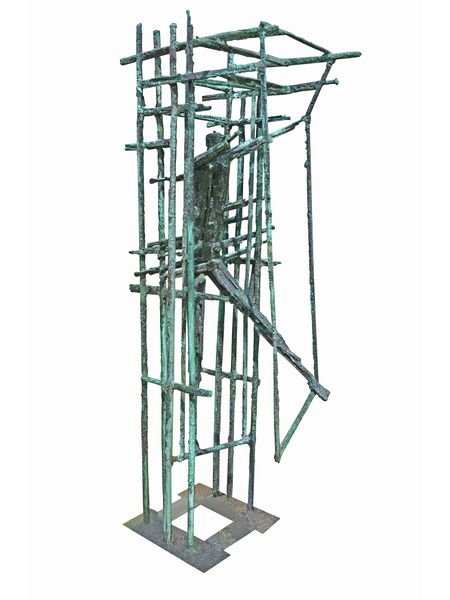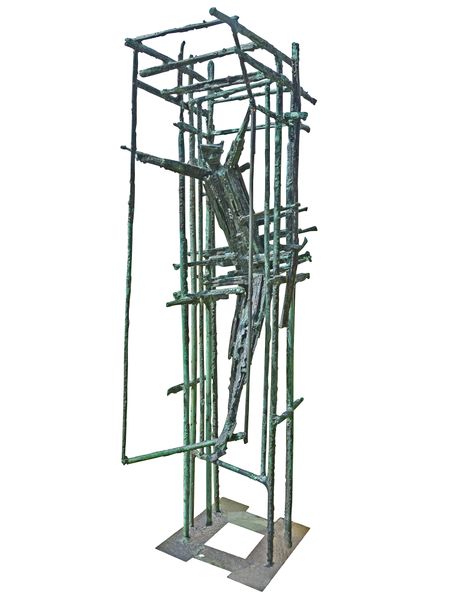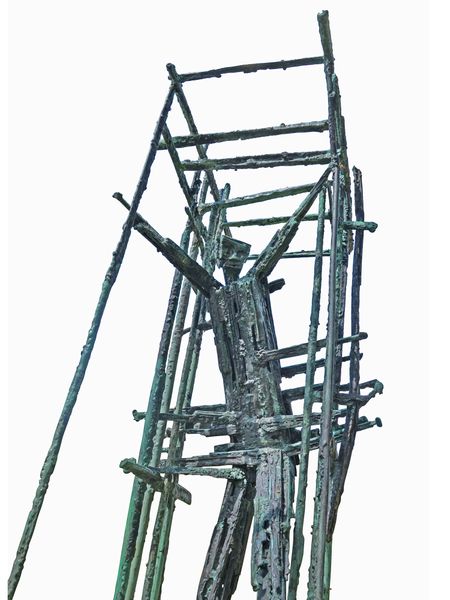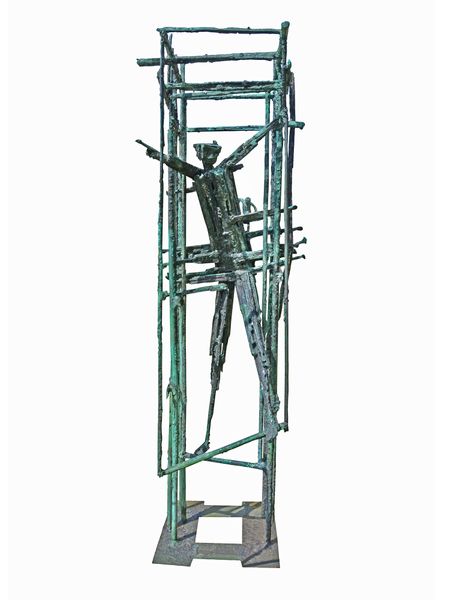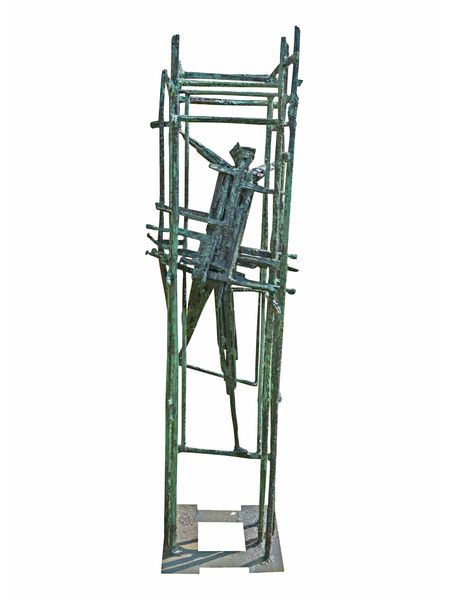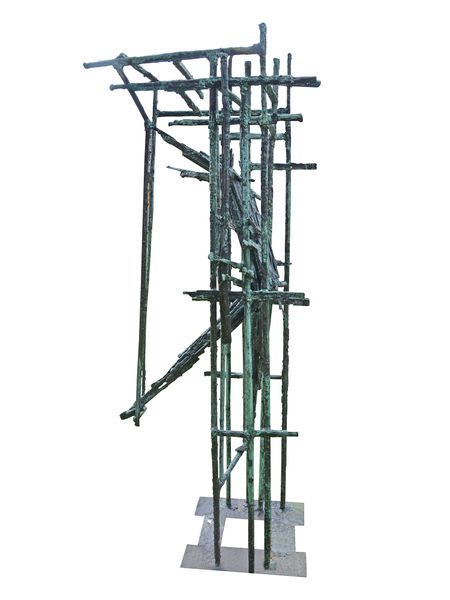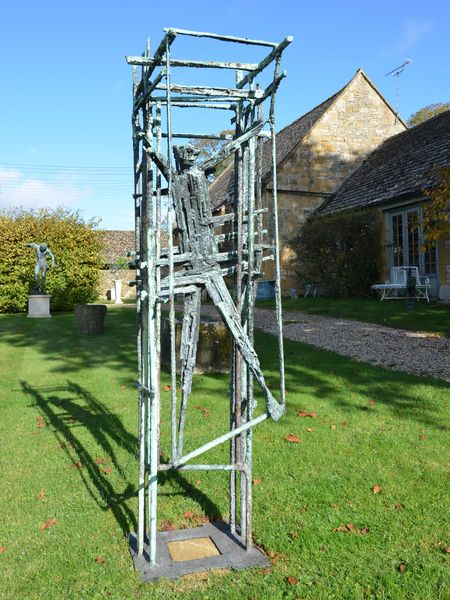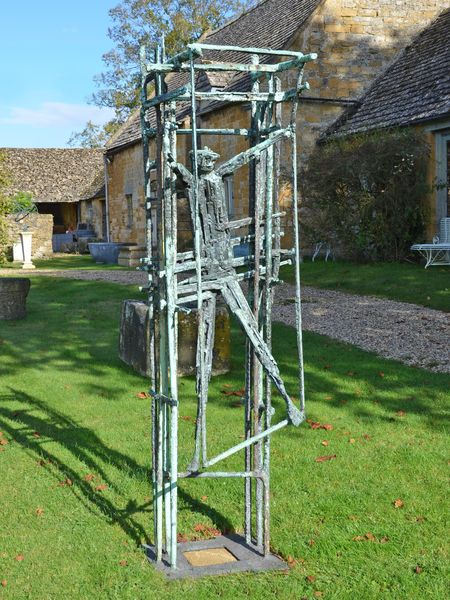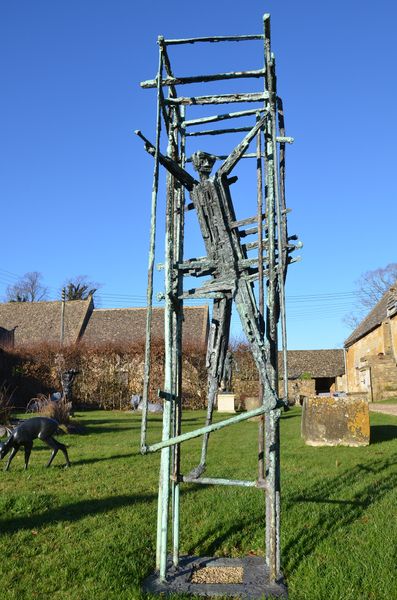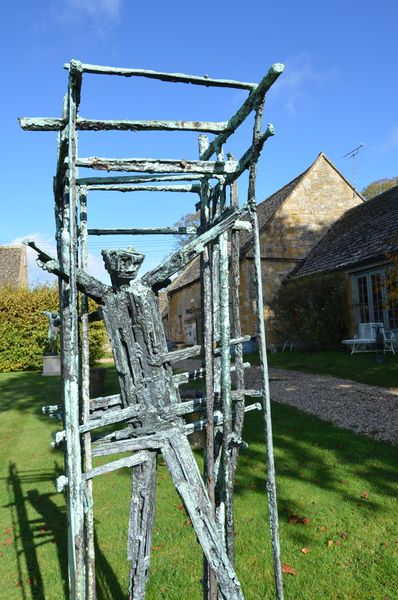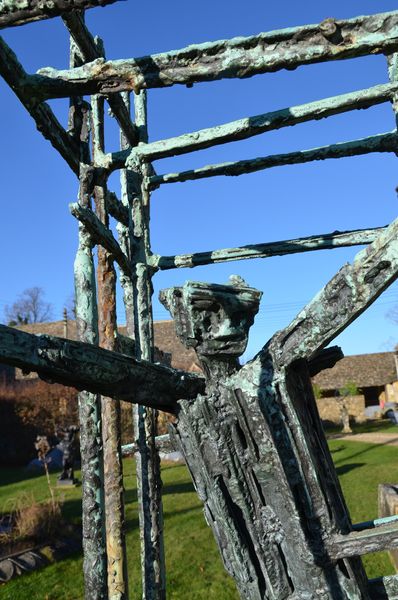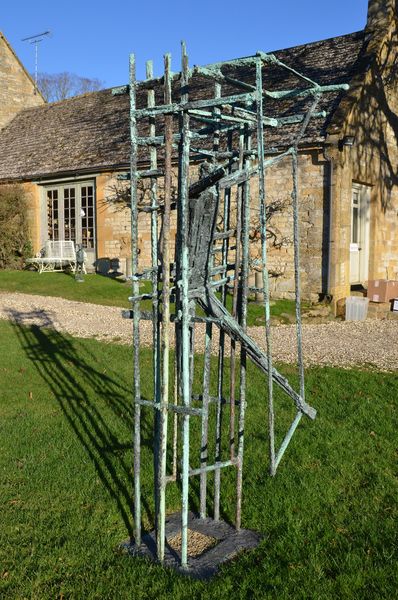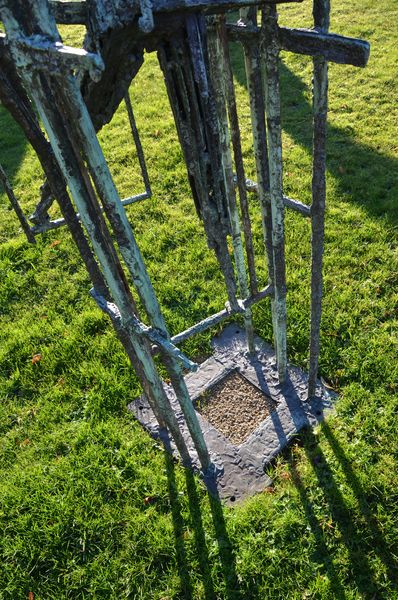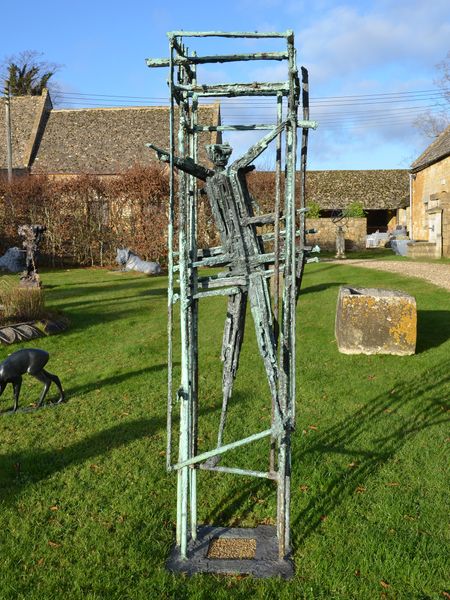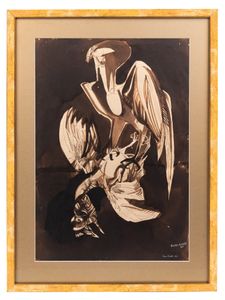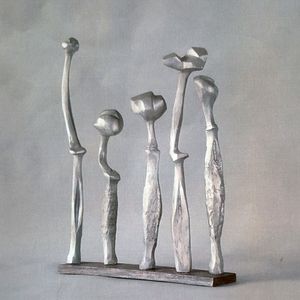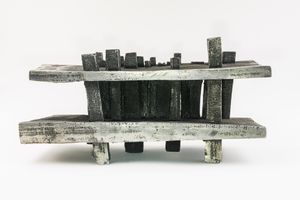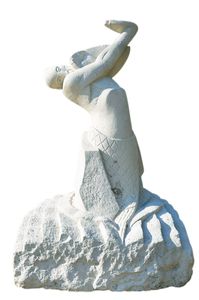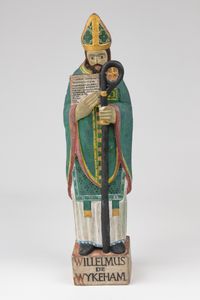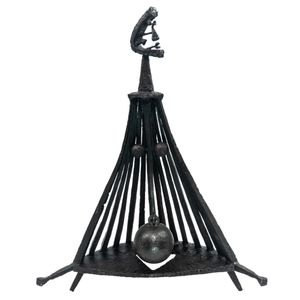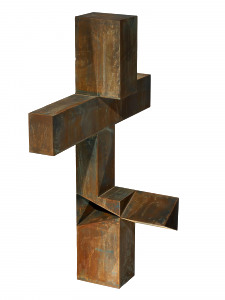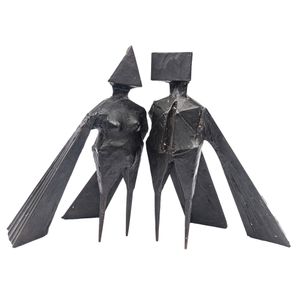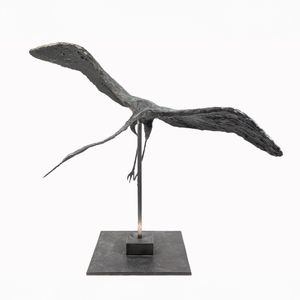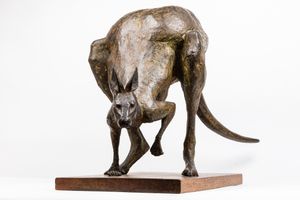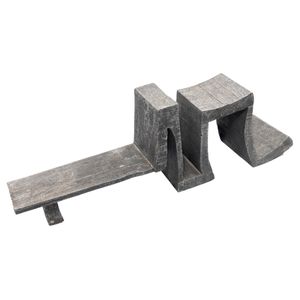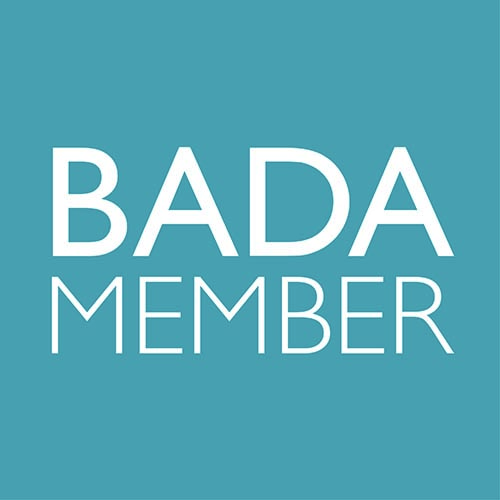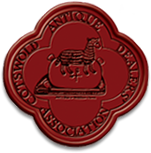LESLIE THORNTON 1925-2016
The Trapeze
LESLIE THORNTON 1925-2016
The Trapeze
Circa 1958
Stock Number: 14538/MB
Height
228.00cm
[89.76 inches]
Width 68.00cm [26.77 inches]
Depth 80.00cm [31.50 inches]
Width 68.00cm [26.77 inches]
Depth 80.00cm [31.50 inches]
Price on application
Artist's Resale Right applies @ plus 4%
Welded bronze
Circa 1958
Unique
PROVENANCE
A private collection USA
Parke-Bernet Galleries, Inc., New York, 19 May 1966, Lot 53
Exhibited
Modern Sculpture, Leeds City Art Gallery, 8 October – 5 November 1958, No.58
Leslie Thornton / Bernard Cohen, Gimpel Fils, London, July 1960, No.1
By early 1957, when Gimpel Fils paired Leslie Thornton’s sculpture with paintings by Louis Le Brocquy, Thornton’s reputation was firmly established. He had exhibited with the London Group in 1953/4, at the ICA in 1955, in British Council touring exhibitions of German and Sweden in 1955–7 and was among the sculptors selected to represent Britain at the São Paulo Biennal in 1957. His work had been acquired by the Arts Council of Great Britain, the collections of Peggy Guggenheim and Nelson Rockefeller and the Museum of Modern Art in New York, whose checklist of new acquisitions exhibited in 1955–6, including Thornton’s Men Fishing from a Pier (1955, iron wire, 55 x 36 x 59 cm), contained Alfred Barr’s description of Thornton as ‘perhaps the best-known sculptor of his youthful generation in England.’ (1) The exhibition at Gimpel Fils in 1957 contained five drawings and ten welded bronze sculptures, described by an anonymous critic in The Times as
[continuing] to explore the possibilities of building expressive puppets out of the struts and bars of a tangled metal scaffolding. The results appear more ingenious than deeply meaningful, but the suggestion of spikes and cages in the forms is nicely matched to the “Figure in a Thicket” and makes a suitably grim object of “The Gallows”. (2)
Thornton’s sculpture was striking not only in its approach to materials but in its subject matter. Welded bronze, as opposed to the more usual practice of casting bronze, was used by a only handful of sculptors at this date, among them, briefly, Geoffrey Clarke. Thornton made a virtue of this unusual technique by constructing unique, intricate compositions that were more durable than welded steel but would have been almost unfeasibly difficult to cast using bronze. Despite the sombre imagery of The Gallows and Gladiators, Thornton’s sculptures from this period frequently portrayed light-hearted subjects, such children playing on stilts, sliding, or performing hand-stands – differentiating them from both the spirit of the ‘geometry of fear’ sculptors and from those displaying an incipient interest in pop art.
The Trapeze (1958) falls squarely within the remit of Thornton’s more playful subjects. In 1958 it was included in an exhibition of Modern Sculpture at Leeds City Art Gallery alongside Thornton’s The Drummer and The Puppets. In 1960, however, it was the maquette version of The Trapeze, almost half the size of the full-scale sculpture, that was exhibited at Gimpel Fils, alongside paintings by Bernard Cohen. This time, the review focused in greater detail on Thornton’s approach and development since the last exhibition:
Mr. Thornton plays a very sophisticated version of the game of making mannikins from matchsticks: his figures seem to be gesticulating extensions of the spars and splinters that make up the chairs and cages and trapezes they find themselves entangled with. They are never lacking in expressiveness and a lively sense of movement, but his new pieces have acquired a degree of solidity which greatly enhances these qualities by making clearer the distinction between the figures and their various “props”. (3)
Less than a year earlier, the maquette for The Trapeze had been illustrated in an article on contemporary English sculpture by the German critic Udo Kultermann, alongside works by Chadwick, Hepworth, Moore, Armitage, Butler, Paolozzi, Dalwood and Caro. (4) Where the maquette incorporates traces of its construction into the composition, notably the ‘blobs’ used to terminate individual scaffolding rods, the larger version is sleeker in outline, as befits its scale. This is a sculpture appropriate to an optimistic post-war vision for Britain, entirely congruent with the new public sculptures being produced for schools and civic spaces.
(1) New Acquisitions Exhibition, 29 November 1955 – 19 February 1956, typescript checklist with notes by Alfred H. Barr, Jnr, p.9.
(2) Anon., ‘A Strange Painter: Pictures by Mr. Louis Le Brocquy’, The Times, 28 February 1957, p.3.
(3) Anon., ‘Mr. Bernard Cohen’s Exhibition: latest reaction in abstract painting’, The Times, 23 August 1960, p.5.
(4) Udo Kultermann, ‘Englische Plastik der Gegenwart’, Das Kunstwerk, 7/XII, January 1959, ill. p.20.
Welded bronze
Circa 1958
Unique
PROVENANCE
A private collection USA
Parke-Bernet Galleries, Inc., New York, 19 May 1966, Lot 53
Exhibited
Modern Sculpture, Leeds City Art Gallery, 8 October – 5 November 1958, No.58
Leslie Thornton / Bernard Cohen, Gimpel Fils, London, July 1960, No.1
By early 1957, when Gimpel Fils paired Leslie Thornton’s sculpture with paintings by Louis Le Brocquy, Thornton’s reputation was firmly established. He had exhibited with the London Group in 1953/4, at the ICA in 1955, in British Council touring exhibitions of German and Sweden in 1955–7 and was among the sculptors selected to represent Britain at the São Paulo Biennal in 1957. His work had been acquired by the Arts Council of Great Britain, the collections of Peggy Guggenheim and Nelson Rockefeller and the Museum of Modern Art in New York, whose checklist of new acquisitions exhibited in 1955–6, including Thornton’s Men Fishing from a Pier (1955, iron wire, 55 x 36 x 59 cm), contained Alfred Barr’s description of Thornton as ‘perhaps the best-known sculptor of his youthful generation in England.’ (1) The exhibition at Gimpel Fils in 1957 contained five drawings and ten welded bronze sculptures, described by an anonymous critic in The Times as
[continuing] to explore the possibilities of building expressive puppets out of the struts and bars of a tangled metal scaffolding. The results appear more ingenious than deeply meaningful, but the suggestion of spikes and cages in the forms is nicely matched to the “Figure in a Thicket” and makes a suitably grim object of “The Gallows”. (2)
Thornton’s sculpture was striking not only in its approach to materials but in its subject matter. Welded bronze, as opposed to the more usual practice of casting bronze, was used by a only handful of sculptors at this date, among them, briefly, Geoffrey Clarke. Thornton made a virtue of this unusual technique by constructing unique, intricate compositions that were more durable than welded steel but would have been almost unfeasibly difficult to cast using bronze. Despite the sombre imagery of The Gallows and Gladiators, Thornton’s sculptures from this period frequently portrayed light-hearted subjects, such children playing on stilts, sliding, or performing hand-stands – differentiating them from both the spirit of the ‘geometry of fear’ sculptors and from those displaying an incipient interest in pop art.
The Trapeze (1958) falls squarely within the remit of Thornton’s more playful subjects. In 1958 it was included in an exhibition of Modern Sculpture at Leeds City Art Gallery alongside Thornton’s The Drummer and The Puppets. In 1960, however, it was the maquette version of The Trapeze, almost half the size of the full-scale sculpture, that was exhibited at Gimpel Fils, alongside paintings by Bernard Cohen. This time, the review focused in greater detail on Thornton’s approach and development since the last exhibition:
Mr. Thornton plays a very sophisticated version of the game of making mannikins from matchsticks: his figures seem to be gesticulating extensions of the spars and splinters that make up the chairs and cages and trapezes they find themselves entangled with. They are never lacking in expressiveness and a lively sense of movement, but his new pieces have acquired a degree of solidity which greatly enhances these qualities by making clearer the distinction between the figures and their various “props”. (3)
Less than a year earlier, the maquette for The Trapeze had been illustrated in an article on contemporary English sculpture by the German critic Udo Kultermann, alongside works by Chadwick, Hepworth, Moore, Armitage, Butler, Paolozzi, Dalwood and Caro. (4) Where the maquette incorporates traces of its construction into the composition, notably the ‘blobs’ used to terminate individual scaffolding rods, the larger version is sleeker in outline, as befits its scale. This is a sculpture appropriate to an optimistic post-war vision for Britain, entirely congruent with the new public sculptures being produced for schools and civic spaces.
(1) New Acquisitions Exhibition, 29 November 1955 – 19 February 1956, typescript checklist with notes by Alfred H. Barr, Jnr, p.9.
(2) Anon., ‘A Strange Painter: Pictures by Mr. Louis Le Brocquy’, The Times, 28 February 1957, p.3.
(3) Anon., ‘Mr. Bernard Cohen’s Exhibition: latest reaction in abstract painting’, The Times, 23 August 1960, p.5.
(4) Udo Kultermann, ‘Englische Plastik der Gegenwart’, Das Kunstwerk, 7/XII, January 1959, ill. p.20.




